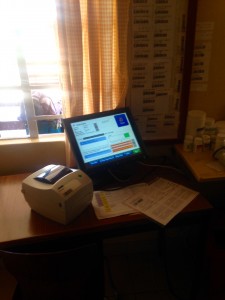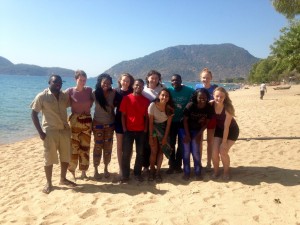This past weekend marked both American and Malawian Independence Day (1), making it one for the books! As the weekend approached, I was reminded of a conversation that we had with our taxi driver, Alex, the first weekend after we arrived. We inquired about what Malawians typically did to celebrate their independence from Britain, and our question was greeted with a knowing chuckle.
That, Alex told us, was a long story.
Apparently, under the previous administration, Malawian independence was a capital B capital D Big Deal. The government would sponsor a massive party and would pull out all the stops: live music, football matches, traditional dancing, free meat and snacks, unlimited beer, and much more. They would hold this party in a different city each year, and would provide transportation (i.e. train passes and bus fare), so that even the poor could come take part in the festivities.
But a few years after the HIV/AIDS epidemic came to establish a firm foothold in Malawi (2), the government was forced to face the facts. Their celebration was permitting the spread of the virus. The provision of free transportation facilitated the unfettered movement of HIV + individuals, and the gathering tended to feed the fires of prostitution in the city where the party was taking place. As a result, HIV epidemics would pop up in villages across the country after each year’s celebration.
Alex’s story got me thinking about the intersections between bioscience and culture, especially where HIV/AIDS is concerned. That in particular is a kind of touchy point, since preventing transmission often involves talking about sex, everyone’s favorite topic for discussion in the public sphere (3). Our experiences in the ART (4) clinic have shown us that St. Gabriel’s does a reasonably good job of reducing social barriers to receiving treatment for HIV, providing services free of charge to anyone who is seropositive or is referred from another clinic. I was particularly impressed with the way that they handled discussions about transmission. Patients became aware about the importance of using contraceptives during pre-clinic education sessions, and then were asked by the ART nurse about their habits. The Malawian government has also done a surprisingly good job of avoiding the politics of blame with their Plan B+ program. In this program, all pregnant women who are found to be HIV+ are placed on ART, regardless of their CD4 count or how they contracted the infection (5). Such initiatives are exciting, as they seem to prioritize the wellbeing of the vulnerable above any sort of judgment call, either on HIV or methods of its transmission. Moreover, St. Gabe’s ART clinic is so incredibly well run (hands down the best use of technology in the entire hospital, not to mention the only comprehensive use of Electronic Medical Records) that it makes me hopeful for the future of HIV treatment and prevention in St. Gabriel’s catchment area.


As optimistic as I am about this particular hospital, a book that I’ve been reading recently keeps reminding me that the story of HIV/AIDS in Malawi is infinitely more complex that I could hope to imagine. In his essay “Politics, Culture, and Medicine: An Unholy Trinity? Historical Continuities and Ruptures in the HIV/AIDS Story in Malawi”, John Lloyd Lwanda unpacks the relationships between Western medicine, tribal tradition, and public policy in Malawi (6). His thesis is that upon the arrival of colonial powers in Malawi, traditional practices and healing were not eclipsed European ideals. Instead, Malawian culture has persisted in a ‘duality’ where political and broad social thought tend to reflect the influences of the British Empire, but village and family life allows for the transmission of tradition and resistance to colonial homogeneity. Merits of either perspective aside, this ‘duality’ holds significant implications for the transmission of HIV in Malawi. As Malawi came to be viewed as a very puritanical society with ‘traditional’ family values, traditions involving the ceremonial deflowering of young women or the prescription of intercourse with a virgin to cure AIDS continued to be practiced in rural areas especially. Essentially, what Lwanda is suggesting is that risk behaviors in Malawi aren’t absent by any means; instead, they’ve gone ‘under the radar’, found mainly in enclaves of tradition that are perpetuated by the village or family. In the face of this reality of dualism, a fight against HIV transmission will require locally and nationally sponsored efforts to redefine ‘tradition’ in a way that prioritizes the safety of all involved in various practices. Although my experiences with traditional medicine and culture have mainly been limited to a few hushed stories on the ward or with Malawian friends, this intersection indicates that HIV transmission may be more firmly embedded in Malawi than I would hope to admit. Within this context, St. Gabe’s efforts at HIV management are even more impressive than what their clinic conveys.

Talking about a more fun type of intersection, this past weekend we traveled to Lake Malawi to meet up with the Blantyre interns. It was a fantastic opportunity to swap stories, compare experiences, and meet some fantastic new friends! If you haven’t done so yet, please take a look at the Malawian Polytechnic interns’ blogs (7): they’re some pretty great people, and the collaboration between Rice and Poly students is truly admirable in its benefits to both sides.
PS: Sorry for the delay in posting! I feel like it’s been a while, but that could be interpreted as a good thing, right? In my case, it means we’ve been busy, both at work and with efforts to absorb Malawian culture like a sponge. I’m happy for the chances to share our experiences with you all, even if they show up a few days later than planned!
(1). July 4th and 6th, respectively. Both were from Britain, actually. Malawians find it surprising and hilarious that the US was originally a British colony as well. Read more about Malawian independence HERE: http://www.bbc.com/news/world-africa-13881367 . And http://www.english.rfi.fr/africa/20140706-malawis-50-years-independence-maturing-democracy-not-enough-says-analyst.
(2). http://dhsprogram.com/pubs/pdf/HF34/HF34.pdf
(3). Please note the strong sarcasm here. Please.
(4). Antiretroviral Therapy
(5). http://www.nyasatimes.com/2013/07/13/malawi-reduces-hivaids-prevalence-rate-to-10-percent/
(6). All this from a super interesting book entitled “HIV/AIDS in Africa: Beyond Epidemiology”. I understand that it might not be everyone’s cup of tea, but definitely a unique take on what’s typically a very cerebral topic.
(7). Here are their blogs:
http://malawi.blogs.rice.edu/author/fmasi/
http://malawi.blogs.rice.edu/author/andalama/
http://malawi.blogs.rice.edu/author/csamuel/
http://malawi.blogs.rice.edu/author/cnyaluwe/